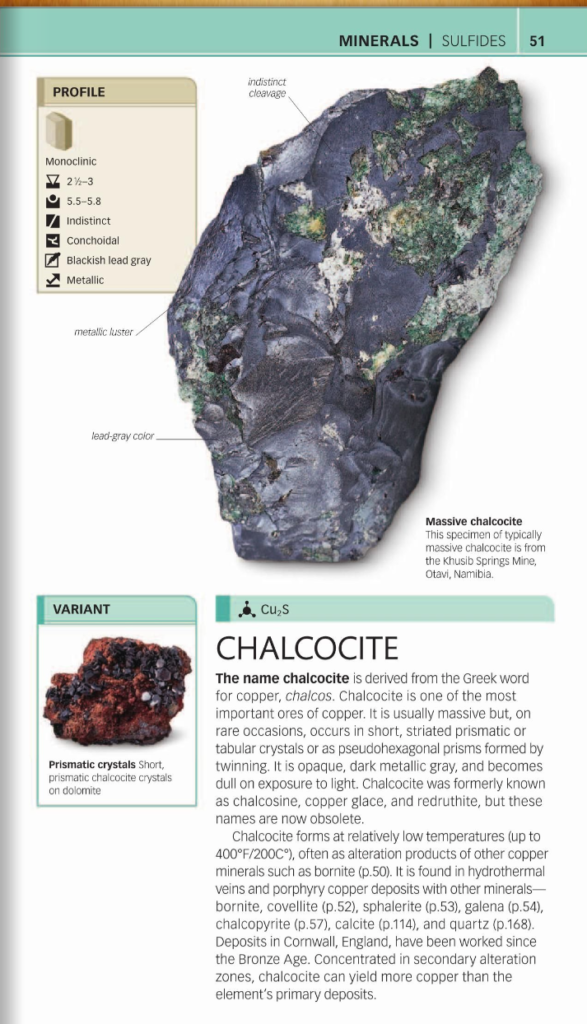Chalcocite: A Comprehensive Overview for Geology Students
Introduction
Chalcocite, also known as copper(I) sulfide (Cu₂S), is one of the most important copper ores for economic mining and geology studies. It is a highly valuable mineral due to its rich copper content, and understanding its properties, formation, and applications is crucial for geology students and professionals alike.
This blog post will dive deep into chalcocite’s formation, geological importance, mining applications, and its role in the copper industry, providing a well-rounded, SEO-optimized resource for geology university students.

What is Chalcocite?
Chalcocite is a supergene mineral that crystallizes in the orthorhombic system. It is a dark gray to black mineral with a metallic luster and has a relatively high specific gravity of 5.5-5.8. Chalcocite is typically soft, with a Mohs hardness of about 2.5-3.
Key Properties of Chalcocite
Chemical Formula Cu₂S
Crystal System Orthorhombic
Color Dark gray to black
Luster Metallic
Specific Gravity 5.5 – 5.8
Hardness 2.5 – 3 (Mohs scale)
Streak Shiny gray
Formation of Chalcocite
Chalcocite typically forms through supergene enrichment processes, where it results from the chemical alteration of pre-existing copper sulfide minerals in the upper zones of ore deposits. These processes occur when copper-bearing sulfides like chalcopyrite, bornite, or covellite react with oxygenated waters at shallow depths, transforming them into chalcocite.
It often forms secondary enrichment zones in copper deposits, particularly in the weathering zones of porphyry copper deposits. Additionally, chalcocite can form in hydrothermal veins at higher temperatures but is more common as a secondary mineral.
Supergene vs. Hypogene Formation:
- Supergene chalcocite forms when copper ore minerals are exposed to surface conditions, undergoing chemical alterations due to oxidation.
- Hypogene chalcocite forms deep below the earth’s surface, in hydrothermal environments, often associated with high-temperature processes.
Geological Occurrence
Chalcocite is predominantly found in porphyry copper deposits and volcanogenic massive sulfide (VMS) deposits. It also occurs in sediment-hosted copper deposits. The largest chalcocite deposits have been discovered in regions such as:
- United States: Particularly in Arizona, Nevada, and Montana.
- Chile: One of the leading copper producers globally.
- Zambia and Congo: Known for their rich copper belt.
- Australia: Notable occurrences in South Australia.
Chalcocite is often associated with other copper sulfides such as chalcopyrite, bornite, and covellite, along with gangue minerals like quartz and calcite.
Importance in Copper Mining
Chalcocite is one of the richest sources of copper ore, containing about 79.8% copper by weight. Due to this high copper content, it is an economically significant mineral in the copper industry. Copper extraction from chalcocite is relatively straightforward due to its high metal concentration and ease of processing compared to other copper sulfides.
In mining, chalcocite is often found in the supergene enrichment zones of copper ore bodies, making it an important target for mining operations. As copper is essential in electrical applications, plumbing, and various industrial processes, chalcocite plays a vital role in supplying this key metal.
Uses of Chalcocite
The primary use of chalcocite is in the production of copper. Copper is used extensively in the following industries:
- Electrical: Copper’s excellent conductivity makes it ideal for electrical wiring and electronic components.
- Construction: Copper is used in plumbing, roofing, and architectural elements.
- Manufacturing: Copper alloys are used in various manufacturing processes, from machinery to tools.
Copper extracted from chalcocite is also crucial in the renewable energy sector, especially in the production of solar panels and wind turbines, which require significant amounts of copper for wiring and components.
How to Identify Chalcocite in the Field
As a geology student, learning how to identify chalcocite in the field is essential. It is typically recognized by its metallic luster and dark gray-black color. When you scratch chalcocite on a porcelain streak plate, it leaves a shiny gray streak, another critical identifying feature.
Chalcocite’s softness compared to other sulfide minerals also helps in identification. A streak test and hardness test are simple but effective methods for field identification.
Chalcocite vs. Other Copper Minerals
Chalcocite Cu₂S 79.8% High copper content, common in supergene zones
Chalcopyrite CuFeS₂ 34.6% More abundant, lower copper content
Bornite Cu₅FeS₄ 63.3% Iridescent tarnish, often a primary copper ore
Covellite CuS 66.5% Bluish color, often found with chalcocite
Conclusion
Chalcocite is not only a vital ore mineral in the copper industry but also an excellent subject of study for geology students. Its formation through supergene enrichment, high copper content, and significant economic value make it a fascinating mineral to explore. Understanding its geological occurrences, mining relevance, and physical properties provides a strong foundation for anyone looking to pursue a career in mining geology or economic geology.
For university geology students, mastering the details of minerals like chalcocite is crucial in building a comprehensive understanding of ore geology and the broader field of mineral exploration.
SEO Keywords:
- Chalcocite mineral
- Copper ore minerals
- Chalcocite properties
- Supergene copper minerals
- Copper extraction
- Chalcocite occurrence
By including relevant SEO keywords and providing detailed explanations, this blog post will not only educate university students but also rank well on search engines, increasing its reach and usefulness.